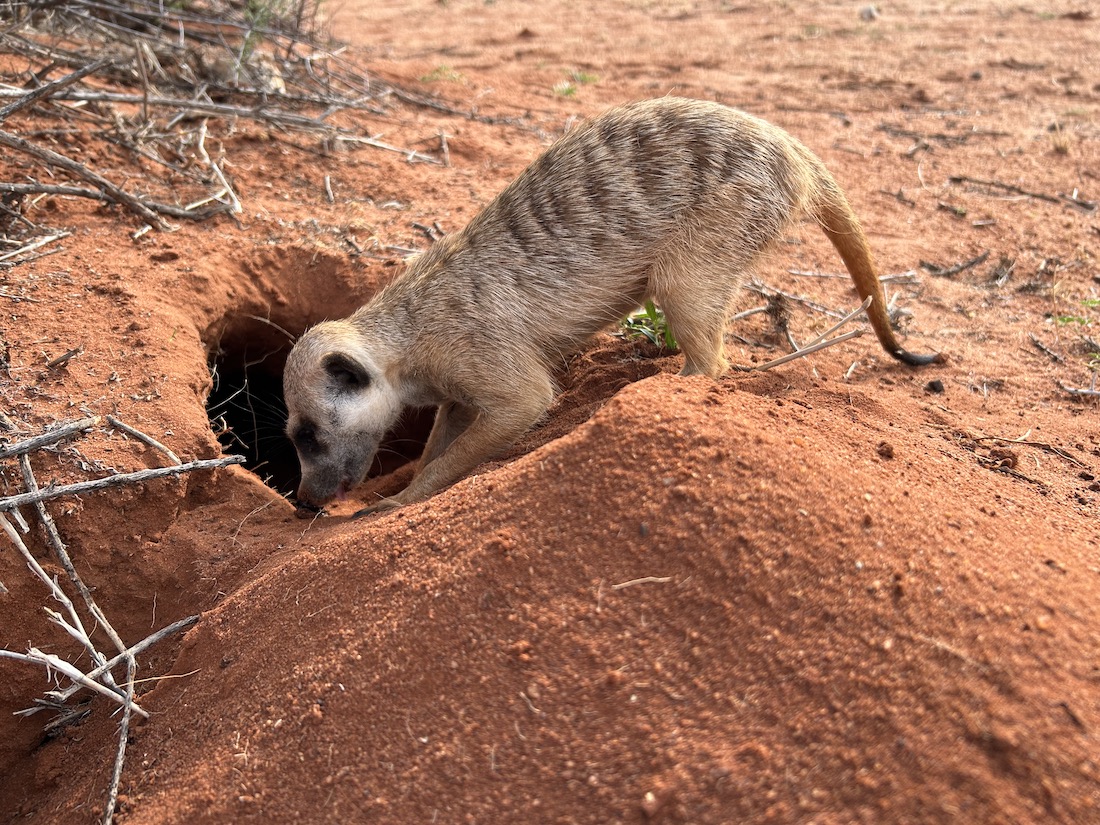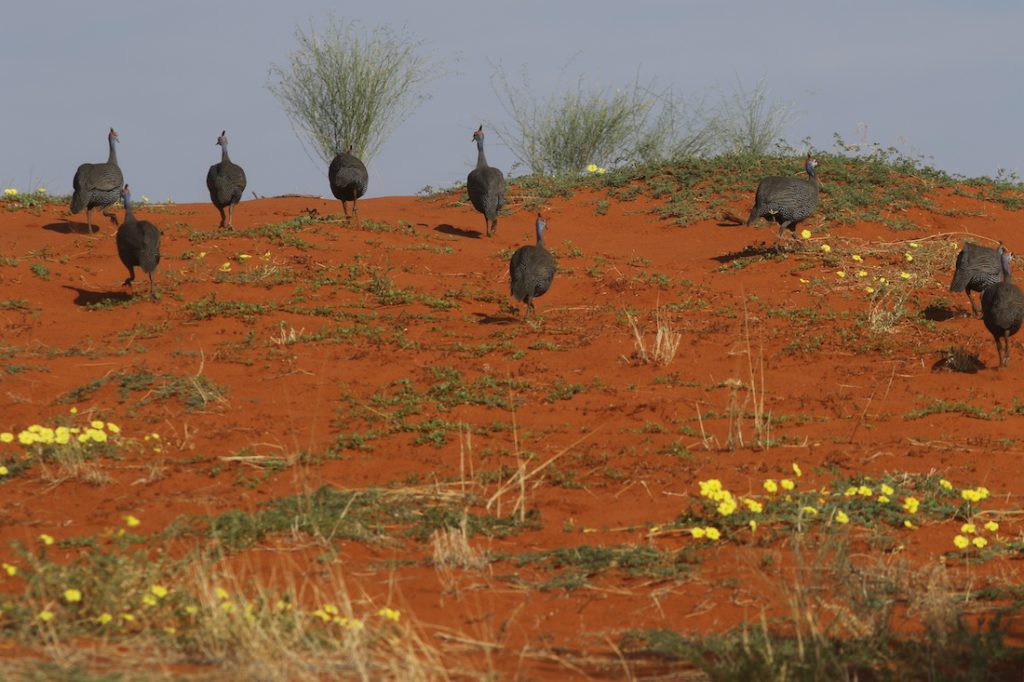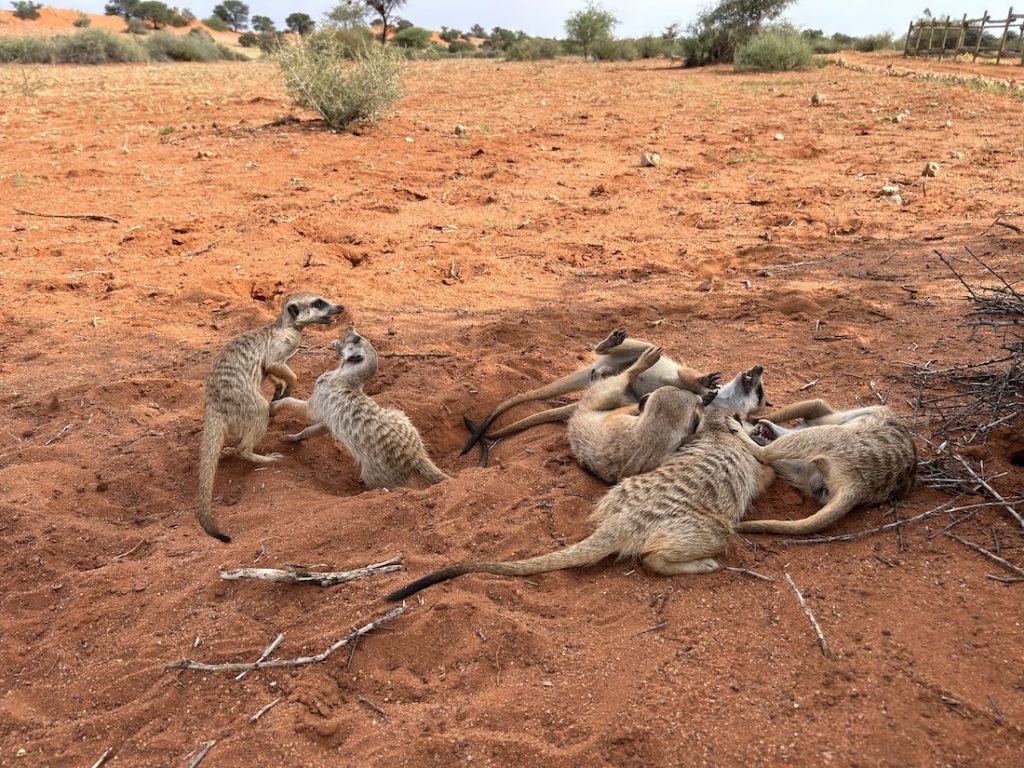Meerkat Memories

A mob of meerkats was on my Southern African menu. Deep in the Kalahari Desert, I scanned that brilliant red earth with my binoculars from dawn until dusk. Finally, on the morning of our third day in Namibia, it was meerkat mania as 20 of them arrived just after breakfast.
This was my 16th trip to Africa, and my third to Namibia. Traveling to 13 countries within the continent, I had never encountered meerkats before. Needless to say, I was a little anxious to see them. In my mind I continuously envisioned the Animal Planet series, Meerkat Manor.
Meerkats maintain a roughly 1.8 square kilometer territory. My girlfriend, marine biologist Holly Lohuis, and I were staying at the Bagatelle Kalahari Game Ranch, which was smack dab in the middle of this band of meerkat’s turf. The dunes were perfectly wind-groomed, the only blemishes were the spoor of springbok, ostrich, helmeted guinea fowl, yellow mongoose, and finally those steadfast meerkats.
Three Hours
That’s how much time we had with these busy, voracious meerkats before they moved onto another region of their desert biome. Fortunately, they were so consumed by foraging for food, they didn’t give a bleep about us and how close we got to them.
In fact, on one occasion, I was so close that beautiful red earth was being kicked onto my camera and lens as they vigorously dug and dug. Several meerkats dug so long I thought they were excavating another den as they keep many throughout their territory. This was about food though. As dirt flew out beneath a determined meerkat that had vanished in a burrow, it soon emerged with a crunchy beetle.
As much foraging as there was, there was also lots of grooming. They all lend a hand to each other during the grooming process. Some of this was done right at my feet, as I sat, watched, and waited as they milled around me. However, as soon as grooming was complete, the meerkat mob was back at it, foraging in the fine earthy sands of the magnificent Kalahari.
Teamwork

As they foraged, several meerkats stood watch like little centurions scouring the desertscape. Standing tall, meerkats have crazy eyesight, and their peripheral vision goes unmatched. The black rings around their eyes act as sun protection against the piercing desert sun. There’s safety in numbers as eagles, jackals, African painted dogs, and snakes are their biggest threats.
Once a potential threat had been detected, a series of chirps and shrieks warned the mob of possible trouble. Their tails went up like spindly radars as the adults’ grouped around a den, and their young were sent below first.
After the mob regrouped, after the threat was defused, foraging continued. The band of 20 meerkats would seemingly spread out and disperse, with just a few remaining. However, a chirp here, a shriek there, and much like a light desert wind blowing across the Kalahari, all 20 members reappeared and were accounted for.
Down Time

These were some of the best, most tender moments with these members of the weasel family. Foraging in that dry desert heat can cause meerkats to overheat a little bit, so they sought out shady spots to rest and relax.
Lazing the day away involved meerkats piling up on top of each other. There were also lots of hugs to go around, the group dynamic playing a large part in meerkat survival. Even more so was the roughhousing that ensued once those pileups became boring.
Within those three hours we soaked in all we could of meerkat behavior, but it flew by quickly. Before we knew it, all 20 meerkats were gone, moving on into other areas of their vast desert realm.
Epilogue
After Holly and I left that corner of the Kalahari, we traveled south to the otherworldly Quiver Tree Forest. On our first evening in the forest dark clouds rolled in at sunset creating a mythical-like scene across the arid landscape.
Early the next morning we saw a small band of meerkats moving quickly through the forest. They appeared super alert, not slowing down for anything. We couldn’t keep track of them and lost them in an endless boulder field beyond the quiver trees.
It was the last time we had a glimpse of any meerkats on that 30-day overland trip. African wildlife is on its own schedule, and sightings of unique desert fauna are so fleeting. Nine months after that stunning Namibian sojourn, I still find tiny red grains of Kalahari sand in the deepest corners of my Atlas camera pack. Thank you, meerkats.






